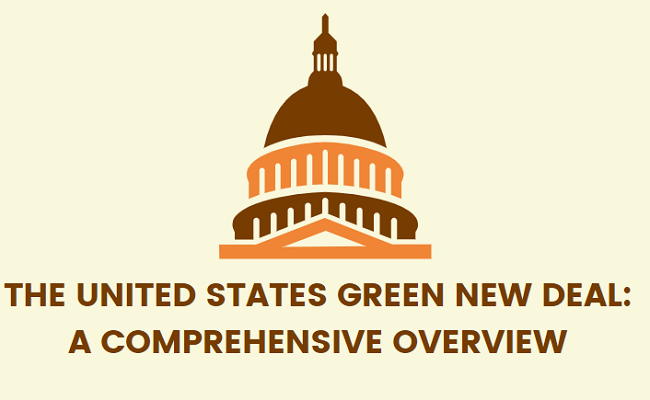The United States Green New Deal (GND) is a term that has garnered significant attention in recent years, particularly in the realm of American politics.
Proposed by Congresswoman Alexandria Ocasio-Cortez (D-NY) and Senator Ed Markey (D-MA) in early 2019, the Green New Deal is a comprehensive policy proposal aimed at addressing two major crises: climate change and economic inequality.
It envisions a radical transformation of the U.S. economy to create jobs, reduce carbon emissions, and promote social and economic justice.
This article will provide a comprehensive overview of the United States Green New Deal, exploring its key components, goals, controversies, and potential impacts.
The Historical Context
The term “Green New Deal” draws inspiration from the original New Deal, a series of social and economic reforms implemented by President Franklin D. Roosevelt in the 1930s in response to the Great Depression.
The Green New Deal, however, adapts the same bold approach to tackle the pressing issues of our time: climate change and economic inequality. It acknowledges the interconnectivity of these crises and the requirement of urgent action.
Core Goals of the Green New Deal
The following are the primary goals of the Green New Deal:
- Mitigating Climate Change: The GND aims to achieve net-zero greenhouse gas emissions in the United States within a decade. It promotes a swift transition to clean, green energy sources while phasing out fossil fuels.
- Job Creation: A cornerstone of the GND is the creation of millions of well-paying, green jobs. These jobs would be in sectors such as renewable energy, energy efficiency, infrastructure, and sustainable agriculture.
- Economic Equity: The GND seeks to address economic inequality by ensuring that we equitably share the benefits of the transition to a green economy, with a focus on disadvantaged communities that are disproportionately affected by environmental and economic challenges.
- Infrastructure Investment: It calls for substantial investments in infrastructure, including upgrading and modernizing transportation systems, energy grids, and buildings, to be more energy-efficient.
- Accessible Healthcare and Education: The GND advocates for universal healthcare and free, high-quality education, recognizing that these factors are vital for economic and social well-being.
Controversies Surrounding the Green New Deal
While the Green New Deal has garnered widespread support among progressive politicians, activists, and many Americans, it has also faced significant opposition and controversy. Key points of contention include:
- Cost: Critics argue that the GND’s ambitious goals come with an enormous price tag, and they question how to fund them without causing economic harm.
- Feasibility: Skeptics raise concerns about the feasibility of achieving such rapid emissions reductions and the potential impact on industries and workers in fossil fuel-dependent regions.
- Role of Government: The GND envisions an expanded role for the federal government in the economy, which some view as an overreach of government power.
- Job Displacement: Critics worry about potential job displacement in traditional industries, such as coal mining and fossil fuel extraction, as the country transitions to a green economy.
Legislative and Policy Proposals
The Green New Deal is still a resolution in Congress, which means it has not yet become law.
The sponsors of the GND have introduced various versions and proposals, but none had passed both chambers of Congress to become legislation. The sponsors have, however, continued to reintroduce the bill to be passed by congress into law.
However, elements of the GND, such as clean energy investment, infrastructure improvements, and climate action, were included in other bills and policy initiatives.
Potential Impacts
If the government enacted the Green New Deal or similar policies, they could have far-reaching impacts on the United States. Some potential outcomes include:
- Economic Growth: The transition to a green economy could stimulate economic growth, create new job opportunities, and reduce long-term environmental and healthcare costs.
- Climate Change Mitigation: Aggressive carbon emissions reductions would contribute significantly to global efforts to combat climate change.
- Reduced Inequality: Targeted policies could help address income and wealth inequality by ensuring that marginalized communities benefit from the transition.
- Technological Innovation: Investment in clean energy and sustainability could drive innovation and position the U.S. as a leader in emerging industries.
Finally, on the Green New Deal
The United States Green New Deal represents a bold and ambitious vision for addressing climate change, economic inequality, and societal well-being.
While it has generated substantial debate and controversy, it has also ignited important discussions about the role of government, the economy, and the environment in shaping the future of the United States.
As the nation continues to grapple with these challenges, the Green New Deal remains a prominent proposal at the intersection of environmental and economic policy.
Its fate and impact will depend on political decisions, public support, and ongoing policy developments in the years ahead.
